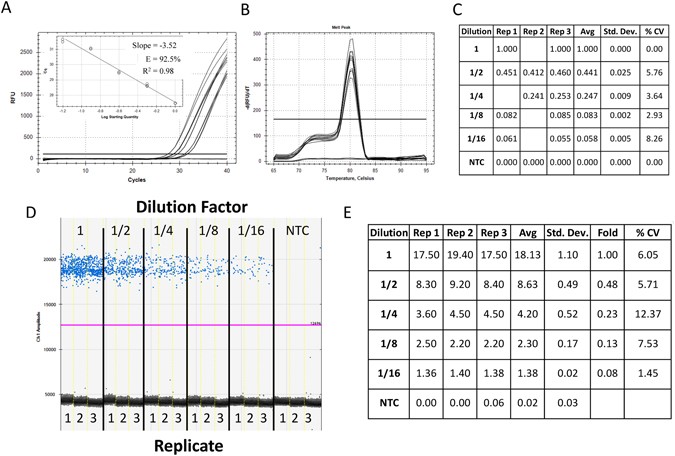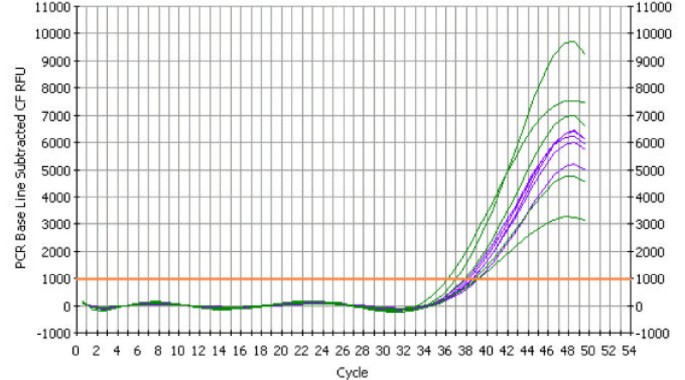

Among intercalator methods, only one assay, which can identify multiple amplicons of potato viruses with different Tm values by the melt curve analysis, was reported. In the intercalator method, the DNA dye is captured to dsDNA, not to single-stranded DNA (ssDNA), in a target non-specific manner, and amplicons can be identified by the melting temperature (Tm), which is measured as the release of the dye during denaturing dsDNA to ssDNA (melt curve analysis). The latter, the intercalator method, is more cost-effective because only two fluorescent dyes, a dsDNA binding fluorescent dye and a reference dye for each well’s standardized fluorescent intensity, need to be compared with fluorescent-labeling probes to each target in the former method. The real-time PCR technique is classified into two methods, one method using fluorescent-labeling probes and the other using double-stranded DNA (dsDNA) binding fluorescent dye. The advantage of this protocol is that as cost-effective as the ELISA it yields results more rapidly however, the subject is still time-consuming for the electrophoretic analysis and the risk of PCR products contamination by open-tube manipulation.Īs a high-throughput alternative, one-step real-time mRT-PCR is a desirable candidate. We have already developed one-step conventional mRT-PCR assays, combined with a filter-paper-based simple RNA preparation for the four major potato viruses and a plant gene as internal control. Toward meeting this need, multiplex reverse transcription-polymerase chain reaction (mRT-PCR)-based assays are becoming common. Enzyme-linked immunosorbent assay (ELISA) has been used in such programs however, many pathogens, including viruses, bacteria, nematodes, and fungi, infect potatoes, such that high-throughput assays alternative to ELISA are required for certification programs. įor controlling virus diseases in potatoes, advanced nations have seed potato certification programs to test seed potato for viruses and grade seed potato lots by their virus-contamination level. These four viruses also are economically important worldwide because these viruses are distributed in most potato-planting areas and reduce the quality and quantity of the yield. In Japan, four virus species of them are mainly found in potato fields: potato leafroll virus (PLRV), potato virus S (PVS), potato virus X (PVX), and potato virus Y (PVY). Potato ( Solanum tuberosum L.), the fourth most important crop in the world, is propagated using tubers and susceptible to more than 30 virus species. This protocol can detect the four viruses in one assay and yield faster results for a vast number of samples, and greatly save the labor for seed potato quarantine and field surveys. This new high-throughput detection protocol using one-step real-time mRT-PCR was sensitive enough to detect viruses in a 100-fold dilution of singly-virus contaminated homogenate in a model assay. According to these criteria, our assay could detect PLRV and PVS from 100-fold dilution of potato leaf homogenate and PVX and PVY from 1000-fold in a model assay. For removing false positives, two criteria were set for the evaluation of result successful amplification was considered as 30.0 ≥ threshold cycle value, and the virus-specific peak higher than the EF1α-specific peak was considered as positive. Based on the calculated Tm values, representative non-Japanese isolates could also be identified by our assay. The reliability of calculation was validated by comparing the calculated Tm values and measured Tm values and the values had a strong linear correlation (correlation of determination: R 2 = 0.9875). The variability of melting temperature (Tm) values for each virus was confirmed using Japanese isolates, and virus species could be identified by the values of 87.6 for PLRV, 85.9 for PVX, 82.2 (Ordinary lineage) to 83.1 (Andean lineage) for PVS, and 79.4 (NA-N strain) to 80.5 (O strain and NTN strain) for PVY on average. Our assay simultaneously detected representative Japanese isolates of PLRV, O lineage of PVS, PVX, and NTN strain of PVY. Virus-specific primers were derived from conserved regions among randomly selected representatives considering viral genomic diversity. We developed an assay based on one-step real-time multiplex reverse transcription-polymerase chain reaction (mRT-PCR) with melt curve analysis for the four viruses and one internal control, potato elongation factor 1 alpha gene ( EF1α).

Among more than 30 virus species infecting potato, potato leafroll virus (PLRV), potato virus S (PVS), potato virus X (PVX), and potato virus Y (PVY) predominate worldwide and should be the targets of a high-throughput detection protocol for seed potato quarantine.


#Real time pcr data analysis excel free#
Certification of seed potato as free of viruses is essential for stable potato production.


 0 kommentar(er)
0 kommentar(er)
